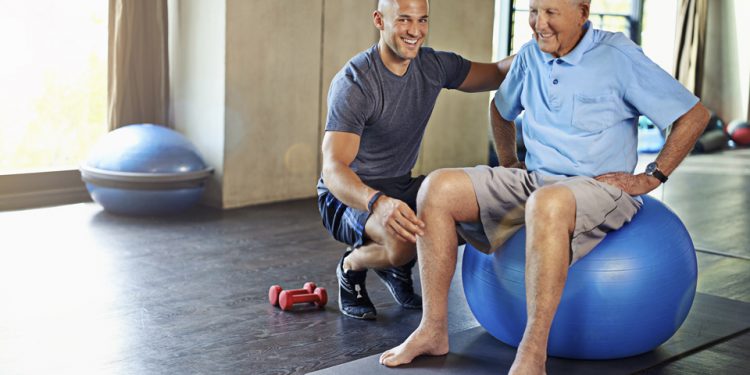Falling can be a serious and life changing event, especially for older adults. There are some simple interventions that can help reduce the risk of falling, and exercise is one of them.
The statistics on falling are somewhat staggering. (1-3)
- More than 1 out of 4 older adults over the age of 65 fall each year, this number has been referenced as high as 1 out of 3 older adults.
- 1 out of 5 falls results in serious injury (i.e., broken bones, head injury).
- Every 20 minutes an older adult dies from a fall.
- Falls are the leading cause of fatal injury among older adults.
- More than 95% of hip fractures are caused by falling.
- Falling is the biggest predictor of another fall.
Falls threaten an older persons independence. Many don’t, or won’t, tell their doctor that they’ve fallen. A fear of falling may lead some older adults to limit their activities, which can create a downward spiraling situation where they become less socially engaged, experience more physical decline and weakness, and become depressed.
Key Risk Factors
There are many risk factors that can contribute to falls. Some of these include (1-2):
- Muscle weakness: Decreased strength in the lower body (and also balance and walking difficulties)
- Foot problems: This can include foot pain, loss of sensation, or even improper footwear (slippers without traction, high heeled shoes, etc.).
- Medical conditions and medications: These include dizziness, vertigo, sleepiness, hypotension, prescription and over-the-counter medications, etc. Have client consult with their doctor and/or pharmacist to address these issues.
- Vision: Our vision needs change as we age. Sometime there is a need for more light or a change in vision/eye wear prescriptions.
- Environmental hazards: These include trip and fall hazards in the home such as unsecured throw rugs, slippery or uneven surfaces, even pets getting under foot. Secure or remove loose rugs, remove clutter, quickly dry spills, install handrails in bathrooms and stairs.
How can exercise help?
Though environmental hazards are the leading cause of falls, gait and balance disorders closely follow. Lower body weakness increases the odds of falling fourfold.(4) Strength programs and balance activities greatly help to reduce the risk of falling.(5,6,7)
After assessing your client for overall functional ability and fall risk (with tests such as the Timed Up and Go (TUG)) follow the Optimum Performance Training® (OPT ®) model for fall prevention programming.
For a scientific approach to designing programs for older adults, click here.
Exercise Programming Tips
Here are some tips on incorporating balance and strength activities into a client’s fall prevention program.(3,7)
Balance
Starting with the balance stabilization level, consider activities such as the single leg balance or single leg balance with reach. These activities require little joint motion and can be progressed with various unstable surfaces or regressed by adding a support, such as a chair.
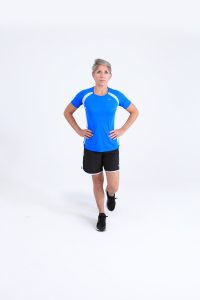 Single leg balance
Single leg balance
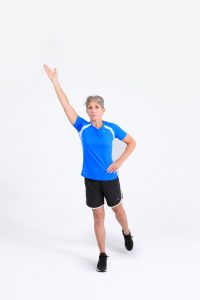 Single leg balance with reach
Single leg balance with reach
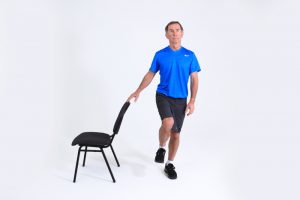 Single leg balance with support
Single leg balance with support
At the balance strength level, moves become dynamic and movement is through a full range of motion with an isometric stabilization hold at the end-range. Examples include step-up to balance or a single leg squat.
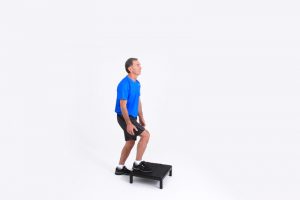 Step up
Step up
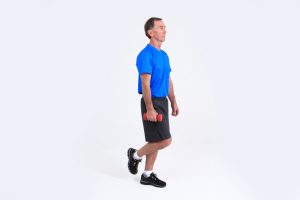 Single leg squat
Single leg squat
Power for fall prevention? Yes, the power level can be used with older adult clients. It develops high levels of eccentric strength, improves neuromuscular efficiency and reactive joint stabilization. Examples include multiplanar hops with stabilization in various planes of motion.
Since many older adults have vestibular issues that can lead to dizziness or a loss of balance when moving in a rotational fashion, always begin balance exercises in the sagittal plane, followed by the frontal plane, then the transverse plane.(1,3) Be sure to have balance assistance nearby or be ready to offer your client a steading spot. This will also help reassure a client and reduce their anxiety.
Tai chi is an activity shown to significantly reduced falls by improving balance, physical performance and reducing the fear of falling.(6,8) During a six-month trial study on the effects of tai chi there was a 55% reduction of falls compared to the those in a stretching control group.
Check out this NASM Roundtable on the importance of Balance Training for more info on its importance!
Strength
Strength moves for fall prevention. Use your training creativity to modify the following lower body exercises to meet your client’s needs across the OPT levels.
Squats / knee bends (supported/unsupported)
Leg extensions (supported/ unsupported)
Hamstring curls (supported/ unsupported)
Calf and toes raises (supported/ unsupported)
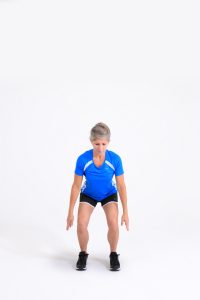 Squats
Squats
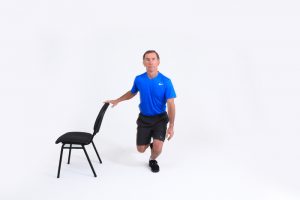 Single leg squat with assistance
Single leg squat with assistance
Core
Core exercises are also important for fall prevention to improve the strength and control of the deep stabilization muscles for lumbo-pelvic-hip complex stabilization. (3)
Stabilization level exercise examples include planks, bird dogs, and supine marching or floor bridges. Strength level could include crunches and back extensions, and ball slams and chest passes for power level moves.
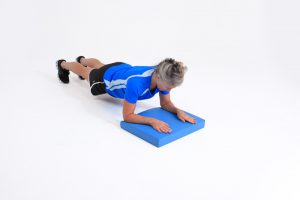 Plank (prone-iso-abs)
Plank (prone-iso-abs)
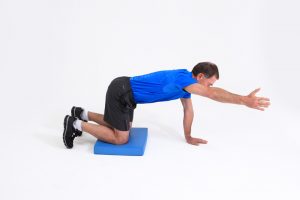 Bird dog (Quadruped arm raise)
Bird dog (Quadruped arm raise)
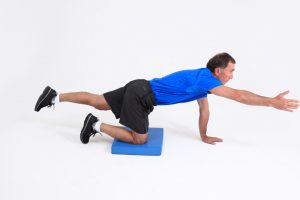 Bird dog (quadruped arm opposite leg raise)
Bird dog (quadruped arm opposite leg raise)
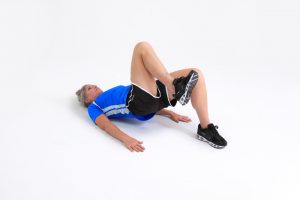 Supine marching
Supine marching
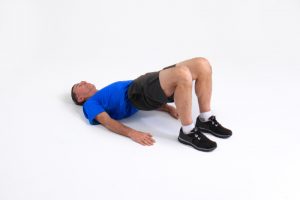 Floor bridges
Floor bridges
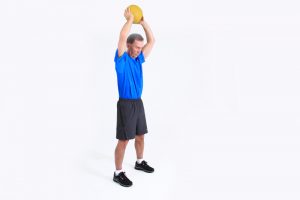 Medicine ball slams
Medicine ball slams
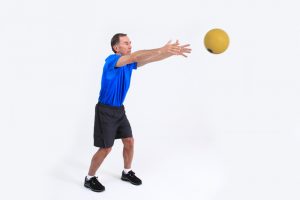 Medicine ball chest pass
Medicine ball chest pass
For more information on working with older adults and fall prevention programming, check out the NASM Senior Fitness Specialization.
References
- Centers for Disease Control and Prevention. Important facts about falls. Accessed online September 20, 2016. https://www.cdc.gov/homeandrecreationalsafety/falls/adultfalls.html
- National Council on Active Aging. Falls Prevention. Accessed September 20, 2016. https://www.ncoa.org/healthy-aging/falls-prevention/
- Stone J, Alexander J, Thompson C, Register-Mihalik J, Barefield K (contributors) NASM Senior Fitness Specialist Manual. (2012)
- Shobha S. Rao, M.D. Prevention of falls in older patients. Am Fam Physician. 2005 Jul 1;72(01):81-88. https://www.aafp.org/afp/2005/0701/p81.html
- Prevention of Falls in Older Persons. AGS/BGS Clinical Practice Guideline. www.medcats.com/FALLS/content/ints/interventions_toc.htm
- Gillespie LD, Gillespie WJ, Robertson MC, Lamb SE, Cumming RG, Rowe BH. Interventions for preventing falls in elderly people. Cochrane Database Syst Rev. 2005;(1):CD000340
- Campbell, A.J. and Robertson, M.C. Otago exercise programme to prevent falls in older adults. https://www.acc.co.nz/PRD_EXT_CSMP/groups/external_providers/documents/publicati ons_promotion/prd_ctrb118334.pdf
- Li F, Harmer P, Fisher KJ, McAuley E, Chaumeton N, Eckstrom E, Wilson NL Tai Chi and fall reductions in older adults: a randomized controlled trial. J Gerontol A Biol Sci Med Sci. 2005 Feb;60(2):187-94. https://www.ncbi.nlm.nih.gov/pubmed/15814861

